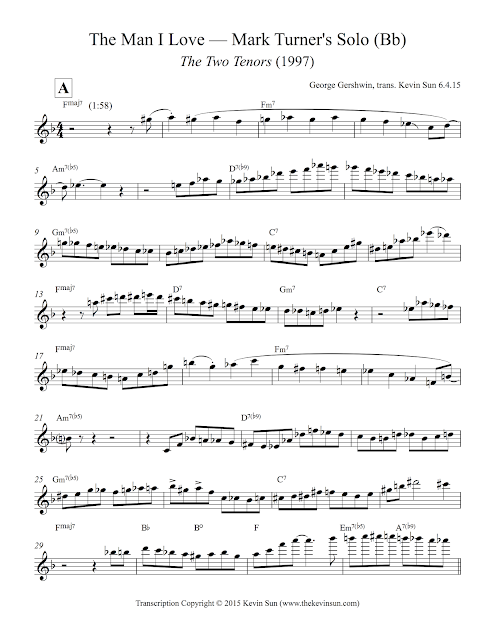Mark Turner on "The Man I Love"
The quarter note plays a big role in the Mark Turner sound, I think. I'm not sure what it is exactly, but there's something intensely pointed and focused about these lines of quarter notes, and they're in full display on this burning "The Man I Love," from Warner Jams, Vol. 2: The Two Tenors (also easily identifiable on other solos from the same record, like "The Plain But The Simple Truth").
I remember being mesmerized as a teenager by Stan Getz's use of long, two-repeated-eighth-note melodies (the intro to "S-H-I-N-E" from West Coast Jazz might be the most obvious example), but aside from the technical aspect of its execution, I remember being able to hear the melodic improvised line more clearly—basically because there were half as many pitches in the same amount of time as an eighth note line. Mark's quarter note lines end up having a similar effect: aside from giving him and listener a break from the dense, substitution and chord alteration-rich eighth note lines he unspools at length, it makes unmistakably clear how he's negotiating/wiggling through the changes (by "wiggle," I mean the opening phrase of the solo). It also seems to grant him more time and consequently more control over where he's steering his melodies, such that he can move from one range of the horn to another and prepare for the start of his next phrase by setting himself down where he wants to be.
In transcribing this early Mark, I'm reminded of some of Miguel's rationale for transcribing earlier Coltrane: the clarity and, in some ways, rote execution of ideas gives you some sense of what was in Trane's practice notebook at the time, even occasionally to the extent that you could glimpse fragments of individual exercises sufficiently suggestive enough that you'd be able to extend and complete them on your own. Many of the substitutions here are almost textbook, the kind of thing that I imagine would be taught in an intermediate jazz harmony class at Berklee, e.g., mm. 6-9's tritone substitution (Ebm7 - Ab7, instead of Am7b5 - D7b9), which, if you'd transpose it a tritone away and play it on the same changes, would be far less ear-catching; or the fourths-shape in mm. 22-3.
I joked with a friend about this recently, but I also think the chromatic scale—or maybe more densely chromatic bebop lines—features largely in the texture of these solos, particular in the altissimo (mm. 32 is the prime culprit). This ability to interpolate chromatic pitches and wind a line around itself using thirds and seconds casts the illusion of stretching a small range of the horn into a larger space, if that makes sense. What I mean is that Mark can play a line that's moving up or down, and something spend more time there in a narrow circumscribed range than seems possible, given the number of pitches—this, all while retaining an overall sense of tonality, or some tonal relation to the ongoing harmony momentum. I've been learning this Harold Land solo recently, and I hear some of the same qualities of "snakeyness," to adapt a phrase I heard from Jaleel Shaw.
Anyway, all speculation on my part. Here's the solo:
C
Bb
Eb
* * * * *
Walter Smith III told me that the first time he heard Mark Turner wasn't on one of Mark or Kurt Rosenwinkel's records, but on this record, Warner Jams, Vol. 2, which came out in high school. He was attending the Jamey Aebersold Camp on a scholarship, and James Moody, who was teaching there, told everyone he'd just made a new record on Warner Brothers with a "great saxophonist, a young guy, Mark Turner."
Here's Walter on hearing that record, and part two of this story:
It was in the late ’90s, the days before internet, and I went instantly, “Who is this guy?” I wanted more ... I was just picking up bits and pieces. The random thing is—that was like 10th and 11th grade—in the 12th grade, I got the YoungArts thing, NFAA, and at the time, part of it you would go to Miami and part of it you would go to play at IAJE with the group. The year that we did it, IAJE was in New York, and we opened up for that Two Tenors, Warner Jams thing.
Everything was coming together, and I saw Mark and I was like, “Oh!” And the only thing I could think to ask, because I really didn’t know anything about him—I was like, “Hey, how old are you?” [laughs] He kind of vibed me out.
It was really funny. He was like, “How old are you?” and he just walked off. Pretty funny.


Comments
Post a Comment